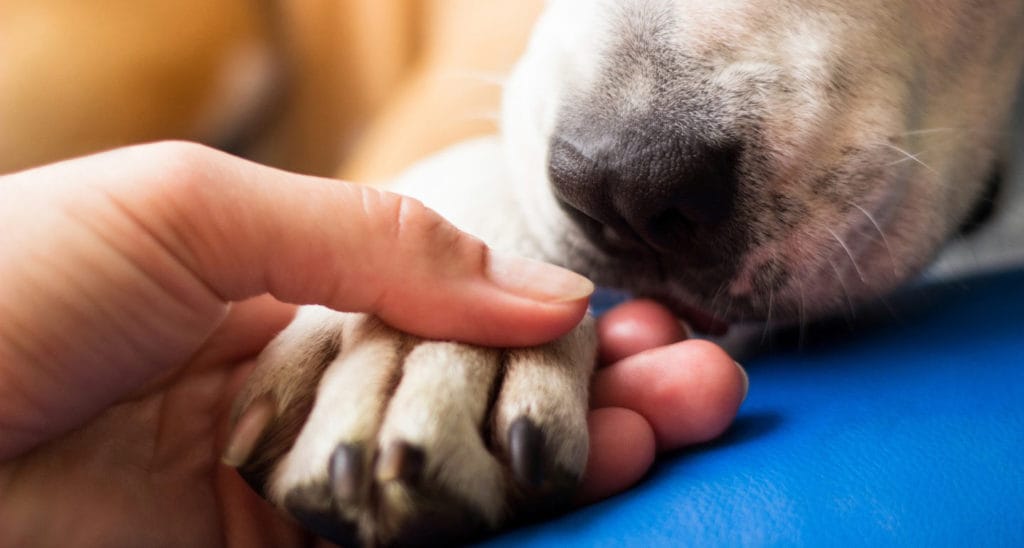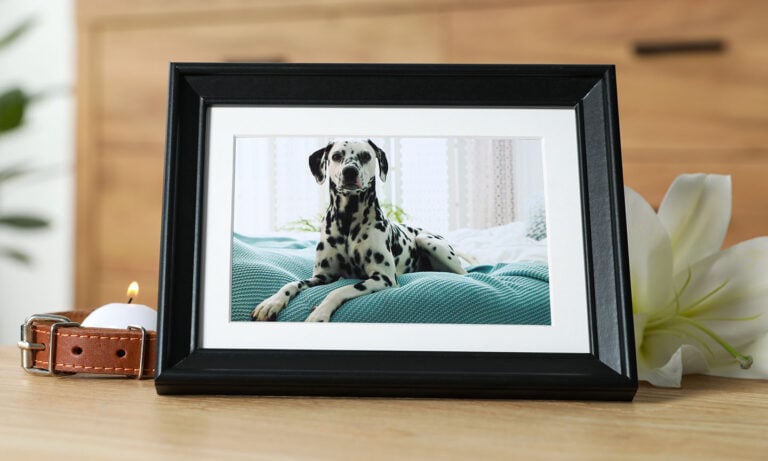After 14 years together, Kimberly Lahm knew it was time to say goodbye to her beloved Sydney. Sydney’s hips and back legs were failing, so she was having difficulty walking. And she didn’t seem like her usual happy self while on the pain medication her veterinarian prescribed. Rather than saying goodbye to Sydney in a vet’s office, Lahm opted for in-home euthanasia, which meant putting her dog down at home.
For 10 days leading up to the scheduled in-home euthanasia, Lahm spoiled her fur baby, a sleek, silver Weimaraner who was nicknamed “Syd.” Just before the veterinarian arrived at Lahm’s home last fall, Syd enjoyed her final meal of burgers and ice cream.
Syd passed away peacefully at home on the bed that she loved, surrounded by some of her favorite friends: Lahm, Lahm’s boyfriend, and her two fur brothers, Bo and Chase.
“Those last moments were exactly what I wanted—me snuggling her for the last time and telling her how much I loved her, how much she enriched my life, and how grateful I was to her for her patience when I was a less-than-ideal dog mom,” Lahm says. “She was truly relaxed and at peace, and I know she didn't feel any pain at the end.”
What Is In-Home Euthanasia?
The term euthanasia comes from the Greek euthanatos, meaning “easy death.” As dogs and cat age or become ill to the point that their quality of life is significantly affected, many pet parents consider putting a pet down to save them from living in pain and discomfort.
Many veterinarians will offer in-home euthanasia services, sometimes call at-home euthanasia, to allow pets and their parents to spend their final moments together in the comfort of their own home.
Six Benefits of Putting a Dog or Cat Down at Home
Lap of Love Veterinary Hospice, a network of veterinarians around the United States who are dedicated solely to end-of-life veterinary care, lists many benefits to putting a dog or cat down at home.
- In-home euthanasia is by appointment, so you can schedule a time that is both convenient and gives you time to prepare emotionally.
- Veterinarian offices are stressful for many pets;in-home euthanasia allows dogs and cats to be in their own surroundings.
- Your pet will be in their favorite location with familiar smells.
- Other pets can be in the room, so they can say goodbye and not be left wondering where their brother or sister went—and when they’re coming back.
- As many family and friends as your home can accommodate can be present.
- After the euthanasia, families can be left to grieve privately.
How to Prepare
Putting a dog or cat down is not an easy decision to make, but there are a few things you can do to prepare yourself.
Assess your pet’s quality of life.
Assessing your pet’s quality of life can help determine if it’s time to consider putting your pet to sleep.
“I never wanted to be that dog owner or ‘mom’ that made my dog endure a poor quality of life, or worse, pain, because I wasn't ready to say goodbye,” Lahm says. “Syd's main loves were hiking and swimming, both of which were approaching impossible. After talking with my vet, we agreed that it was a good time because she wasn't in incredible pain and could still enjoy her last days. That was important to me.”
The Quality of Life Scale, created by Dr. Alice Villalobos, DVM, the director of Pawspice and Animal Oncology Consultation Service in Southern California, can help you and your veterinarian make the best decision for your pet.
Talk to your vet.
“One of the really important things that we do is try to help people understand that it doesn’t really fall on your shoulders to make the decision to euthanize your pet,” says Dani McVety, DVM, co-founder of Lap of Love. “Call us or talk to your regular vet. When you can’t manage the pain for your pet, so you know things are getting worse, or you’re not willing to continue anymore diagnostics, we're trained to give options.... Let’s talk about what your options are.”
Find an in-home euthanasia service.
If your veterinarian doesn’t offer at-home euthanasia services, do some research. Either ask for a recommendation or call local veterinarians in your area. A quick internet search will also yield several options.
Understand the costs.
Putting a dog down at the veterinarian will have a cost, but is less expensive than putting a dog down at home. Lahm paid approximately $700, which included an additional $150 charge for the in-home service and also included individual cremation, which was important to her. (If cost is a factor, you can opt to have your pet cremated with other animals.)
Prepare for the day.
McVety suggests doing anything to make the day—and the moment—about your pet.
“I’ve seen everything. There was a Labrador that loved the pool, so I euthanized him on a floatie in a pool,” she says. “Another loved to go in the car, so I crawled in the car. I’ve driven to the beach and euthanized a dog on the beach at sunset. I’ve been there with one person and 50 people in the room.
“Anything is possible if you can dream it up,” she continues. “Whatever honors that [pet] I think is the most important.”
No one knows your pet better than you and your veterinarian, so the moment you think it may be time to consider putting your dog or cat down, start the process of talking to your vet and weighing the benefits if in-home euthanasiais the best option. Ultimately, it’s no one else’s decision but yours.
“I really felt it was my responsibility to be there for [Syd], to honor her life, and let her go with peace and dignity,” Lahm says. “After all she gave me in her life, I know I was able to give that to her in her last moments.”
Share:









